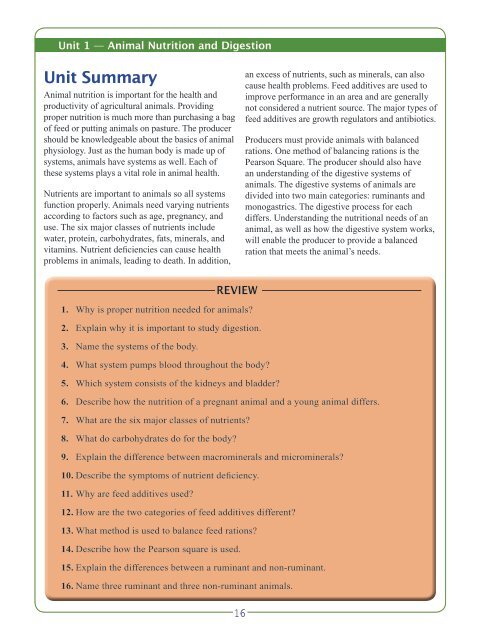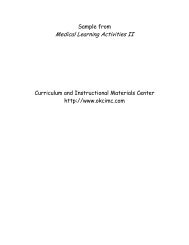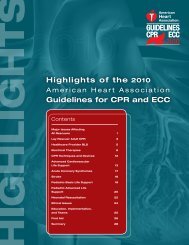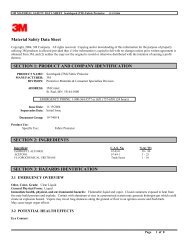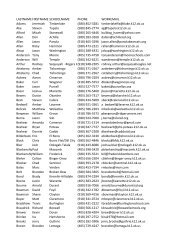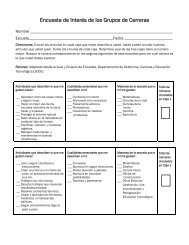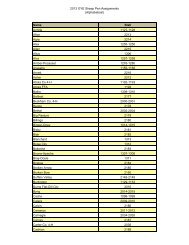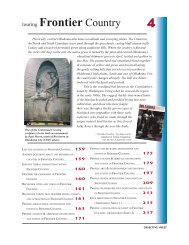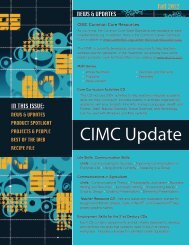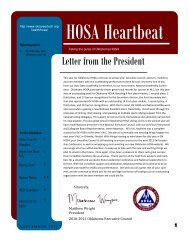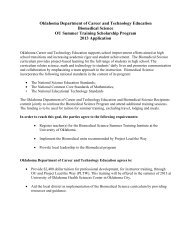Animal Nutrition and Digestion (PDF file, 5.95 MB)
Animal Nutrition and Digestion (PDF file, 5.95 MB)
Animal Nutrition and Digestion (PDF file, 5.95 MB)
Create successful ePaper yourself
Turn your PDF publications into a flip-book with our unique Google optimized e-Paper software.
Unit 1 — <strong>Animal</strong> <strong>Nutrition</strong> <strong>and</strong> <strong>Digestion</strong><br />
Unit Summary<br />
<strong>Animal</strong> nutrition is important for the health <strong>and</strong><br />
productivity of agricultural animals. Providing<br />
proper nutrition is much more than purchasing a bag<br />
of feed or putting animals on pasture. The producer<br />
should be knowledgeable about the basics of animal<br />
physiology. Just as the human body is made up of<br />
systems, animals have systems as well. Each of<br />
these systems plays a vital role in animal health.<br />
Nutrients are important to animals so all systems<br />
function properly. <strong>Animal</strong>s need varying nutrients<br />
according to factors such as age, pregnancy, <strong>and</strong><br />
use. The six major classes of nutrients include<br />
water, protein, carbohydrates, fats, minerals, <strong>and</strong><br />
vitamins. Nutrient deficiencies can cause health<br />
problems in animals, leading to death. In addition,<br />
an excess of nutrients, such as minerals, can also<br />
cause health problems. Feed additives are used to<br />
improve performance in an area <strong>and</strong> are generally<br />
not considered a nutrient source. The major types of<br />
feed additives are growth regulators <strong>and</strong> antibiotics.<br />
Producers must provide animals with balanced<br />
rations. One method of balancing rations is the<br />
Pearson Square. The producer should also have<br />
an underst<strong>and</strong>ing of the digestive systems of<br />
animals. The digestive systems of animals are<br />
divided into two main categories: ruminants <strong>and</strong><br />
monogastrics. The digestive process for each<br />
differs. Underst<strong>and</strong>ing the nutritional needs of an<br />
animal, as well as how the digestive system works,<br />
will enable the producer to provide a balanced<br />
ration that meets the animal’s needs.<br />
Review<br />
1.<br />
2.<br />
3.<br />
4.<br />
5.<br />
6.<br />
7.<br />
8.<br />
9.<br />
Why is proper nutrition needed for animals?<br />
Explain why it is important to study digestion.<br />
Name the systems of the body.<br />
What system pumps blood throughout the body?<br />
Which system consists of the kidneys <strong>and</strong> bladder?<br />
Describe how the nutrition of a pregnant animal <strong>and</strong> a young animal differs.<br />
What are the six major classes of nutrients?<br />
What do carbohydrates do for the body?<br />
Explain the difference between macrominerals <strong>and</strong> microminerals?<br />
10. Describe the symptoms of nutrient deficiency.<br />
11. Why are feed additives used?<br />
12. How are the two categories of feed additives different?<br />
13. What method is used to balance feed rations?<br />
14. Describe how the Pearson square is used.<br />
15. Explain the differences between a ruminant <strong>and</strong> non-ruminant.<br />
16. Name three ruminant <strong>and</strong> three non-ruminant animals.<br />
16


